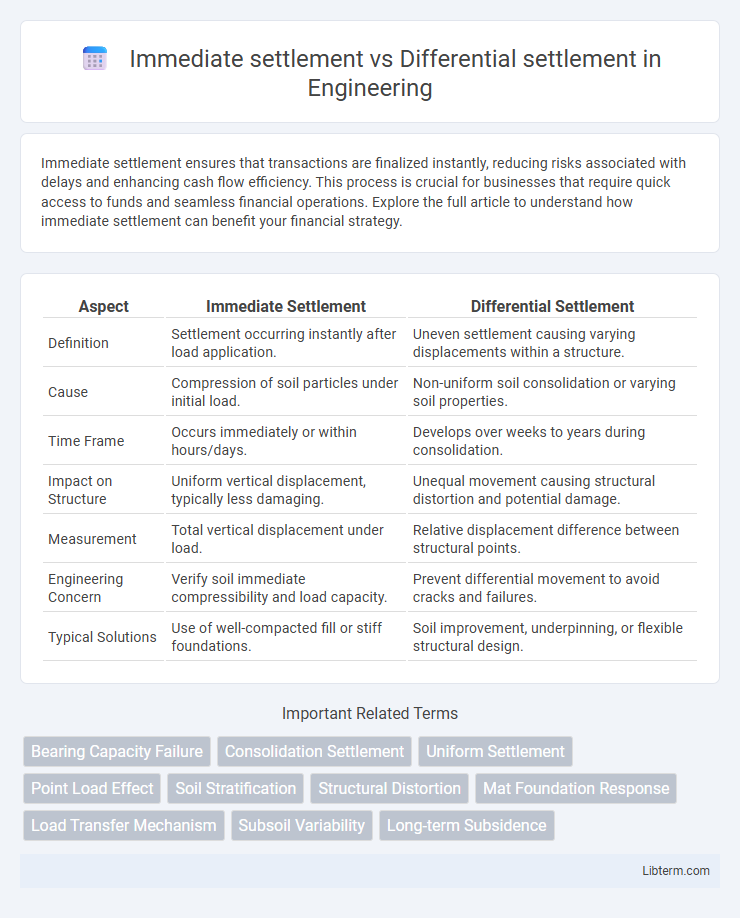Immediate settlement ensures that transactions are finalized instantly, reducing risks associated with delays and enhancing cash flow efficiency. This process is crucial for businesses that require quick access to funds and seamless financial operations. Explore the full article to understand how immediate settlement can benefit your financial strategy.
Table of Comparison
| Aspect | Immediate Settlement | Differential Settlement |
|---|---|---|
| Definition | Settlement occurring instantly after load application. | Uneven settlement causing varying displacements within a structure. |
| Cause | Compression of soil particles under initial load. | Non-uniform soil consolidation or varying soil properties. |
| Time Frame | Occurs immediately or within hours/days. | Develops over weeks to years during consolidation. |
| Impact on Structure | Uniform vertical displacement, typically less damaging. | Unequal movement causing structural distortion and potential damage. |
| Measurement | Total vertical displacement under load. | Relative displacement difference between structural points. |
| Engineering Concern | Verify soil immediate compressibility and load capacity. | Prevent differential movement to avoid cracks and failures. |
| Typical Solutions | Use of well-compacted fill or stiff foundations. | Soil improvement, underpinning, or flexible structural design. |
Understanding Immediate Settlement
Immediate settlement refers to the rapid compression of soil occurring right after a load is applied, primarily in granular soils with low compressibility and high permeability. This type of settlement happens because the soil particles rearrange and the void spaces are reduced almost instantly, without significant water displacement. Understanding immediate settlement is crucial for designing foundations on sandy soils where rapid load transfer and minimal time-dependent deformation are expected.
Exploring Differential Settlement
Differential settlement occurs when different parts of a structure settle unevenly due to variations in soil properties, load distribution, or foundation conditions, causing structural stress and potential damage. This type of settlement is critical to monitor in construction projects because it can lead to cracks, tilting, and even failure if not properly addressed through foundation design or ground improvement techniques. Unlike immediate settlement, which happens rapidly after load application, differential settlement develops over time and requires detailed geotechnical analysis to predict and mitigate its impact on structural integrity.
Causes of Immediate Settlement
Immediate settlement occurs rapidly after the application of load, primarily caused by the compression of water-filled voids in saturated soils such as clays and silts, where soil particles rearrange under sudden stress. This type of settlement is driven by the expulsion of pore water from soil pores due to the increase in effective stress without significant time delay. Factors influencing immediate settlement include soil permeability, initial void ratio, and the magnitude of the applied load.
Factors Leading to Differential Settlement
Differential settlement occurs when different parts of a structure settle unevenly due to variations in soil properties, load distribution, and moisture content beneath the foundation. Factors leading to differential settlement include heterogeneous soil composition, varying soil compaction levels, inconsistent groundwater fluctuations, and irregular foundation loading. Immediate settlement, by contrast, is mainly influenced by the elastic deformation of soil under applied loads without significant long-term soil consolidation.
Effects of Immediate and Differential Settlement on Structures
Immediate settlement occurs rapidly after load application, primarily affecting the structural foundation by causing uniform downward movement, which can lead to minor cracking and possible distortion if the load is excessive. Differential settlement involves uneven ground subsidence beneath different parts of a structure, resulting in tilting, cracking, and structural damage due to differential stresses and deformation. Understanding these settlement types is critical for designing foundations that minimize structural damage and maintain integrity over time.
Methods for Measuring Settlement
Immediate settlement is typically measured through surface settlement markers, leveling surveys, and inclinometer readings to capture rapid soil compression under load, while differential settlement is assessed using precision leveling techniques, tiltmeters, and electronic displacement sensors to detect uneven ground movement over time. Settlement plates and extensometers provide quantitative data to distinguish between uniform and differential settlement patterns. Accurate measurement employs a combination of geotechnical instruments and real-time monitoring systems to ensure structural stability and design adjustment.
Prevention Strategies for Immediate Settlement
Immediate settlement occurs when soil beneath a structure compresses rapidly under load, causing swift vertical displacement, while differential settlement involves uneven subsidence between different parts of a structure, leading to distortions and structural damage. Prevention strategies for immediate settlement emphasize thorough soil investigation, improving soil bearing capacity through compaction or grouting, and using deep foundations such as piles or caissons to transfer loads to stable strata. Selecting appropriate construction materials and maintaining uniform load distribution also mitigate rapid soil compression and enhance soil stability during early loading.
Minimizing Risks of Differential Settlement
Minimizing risks of differential settlement involves thorough soil analysis and uniform foundation design to prevent uneven ground movement that can cause structural damage. Employing techniques such as soil stabilization, proper load distribution, and continuous monitoring helps control varying settlement rates across a building site. Immediate settlement occurs rapidly after load application, but managing differential settlement ensures long-term structural integrity by addressing soil heterogeneity and load inconsistencies.
Case Studies: Immediate vs Differential Settlement Problems
Case studies highlight immediate settlement issues in soft clay foundations where rapid load application causes sudden displacement and structural distress, exemplified by the Kuala Lumpur LRT line project. Differential settlement problems appear in uneven soil strata conditions, causing differential movement between building sections, as observed in the Leaning Tower of Pisa restoration efforts. Engineering analyses emphasize soil consolidation rates and load distribution factors to mitigate settlement discrepancies in infrastructure design.
Conclusion: Choosing the Right Foundation Approach
Immediate settlement occurs shortly after construction and is typically uniform, while differential settlement involves uneven ground movement causing structural stress. Selecting the right foundation approach depends on soil conditions, load requirements, and long-term ground behavior predictions. Geotechnical analysis and site-specific evaluations ensure optimal foundation design to minimize settlement risks and enhance structural integrity.
Immediate settlement Infographic

 libterm.com
libterm.com